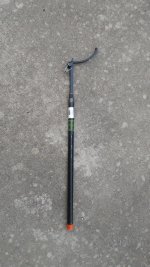Thanks for the clarification. I wasn't aware of this tool. In fact, I'm surprised I didn't come across it when I was fighting with flywheel removal. This appears to be the Lisle version I found via a Google search (should have searched before asking for clarification). I will also look at whether I have a lengthy piece of angle stock that I could bolt to the flywheel. I fear breaking a flywheel tooth with the Lisle flywheel turner, if it pops out of the tooth. . .
Not gonna happen if the points on the flywheel turner fit in square/perpendicular into the flywheel teeth notches and they are centered for full grip.
If you can't get one of the points on the flywheel turner to fit well in the teeth gap, you might need to heat the arm somewhat and bend the arm slightly to better engage the teeth. I don't think you'll have that issue on that larger 150/175 hp flywheel. On the 90/100/115 hp V4, it might be necessary.
I would recommend you just pick up the 3/4 inner LP black pipe 24 inch pipe, it's about $10 to $12 at a Lowes/Home Depot, etc. and just buy two of the Lisle flywheel turners if you want a short and long version. Less fabrication work involved. Use the time savings on getting the powerhead installed.
OMC outboard technicians have been torqueing the flywheel for years on these motors using the flywheel turner. If it was an issue, there would be warnings/alternatives suggested by people like Fastbullet or racerone to address it.
Worst case, buy the Snap on model of the flywheel turner if you feel the need to get the factory recommended flywheel turner.
FYI, I do not use hand tools taking off the flywheel nut. I use impact gun to get it off with the flywheel turner to hold the flywheel steady. I just take it slow and careful by using the low or medium impact gun torque setting.
Most marine outboard technicians from what I hear of never use hand tools for flywheel removal unless it is a model that is known that must be done only with hand tools.






















